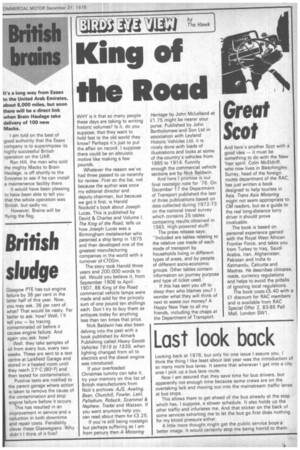British sludge
Page 27

If you've noticed an error in this article please click here to report it so we can fix it.
Glasgow PTE has cut engine failure by 36 per cent in the latter half of this year. Now, you may ask, 36 per cent of what? That would be nasty. Far better to ask: how? Well, I'll tell you — by tracing contaminated oil before it causes engine failure. And again you ask: how?
Well, they take samples of oil from every bus, every two weeks. These are sent to a test centre at Larkfield Garage and stored in a heated room until they reach 27'C (80'F) and then tested for contamination.
Positive tests are notified to the parent garage where action is taken to remove the cause of the contamination and stop engine failure before it occurs.
This has resulted in an improvement in service and a reduction in both downtime and repair costs. Fiendishly clever these Glaswegians. Why didn't I think of it first? WHY is it that so many people these days are taking to writing historic volumes? Is it, do you suppose, that they want to hold fast to the old world they know? Perhaps it's just to put the affair on record. I suppose there could be an altruistic motive like making a few pounds.
Whatever the reason we've had three passed to us recently for review. First on the list, not because the author was once my editorial director and deputy chairman, but because we got it first, is Harold Nock°ld's book about Joseph Lucas. This is published by David & Charles and Volume I, The King of the Road, tells us how Joseph Lucas was a Birmingham metalworker who patented a ship lamp in 1875 and then developed one of the greatest manufacturing companies in the world with a turnover of £700m.
The story took Harold three years and 200,000 words to tell. Would you believe it, from September 1906 to April 1907, 86 King of the Road commercial vehicle lamps were made and sold for the princely sum of one pound ten shillings each. Don't try to buy them as antiques today for anything less than ten times that price.
Nick Baldwin has also been delving into the past with a book published by Almark Publishing called Heavy Goods Vehicles 1919 to 1939, when lighting changed from oil to electrics and the diesel engine was introduced.
If your overloaded
Christmas tummy can take it, try your memory on this list of British manufacturers from Nick's archives. AJS, Aveling, Bean, Churchill, Fowler, Latil, Palladium, Robuck, Scammel & Nephew, Trader and Watson. If you want anymore help you can read about them for £3.25.
If you're still being nostalgic but perhaps suffering as I am from penury then A Motoring Heritage by John McLelland at £1 .75 might be nearer your purse. Published by John Bartholomew and Son Ltd in association with Leyland Historic Vehicles Ltd, it is nicely done with loads of illustrations and looks at some of the.country's vehicles from 1885 to 1914. Funnily enough the commercial vehicle sections are by Nick Baldwin.
And here I promise is our final nostalgic note for '76. On December 17 the Department of Transport published the last of three publications based on data collected during 1972-73 on the national travel survey which contains 25 tables comparing results obtained in 1965. High-powered stuff!
The press release says: "Included are tables relating to the relative use made of each mode of transport by households living in different types of areas, and by people of different socio-economic groups. Other tables contain information on journey purpose and type of ticket used.
If this has sent you off to sleep then who blames you? I wonder what they will think of next to waste our money? A Happy New Year to all my friends, including the chaps at the Department of Transport.




























































